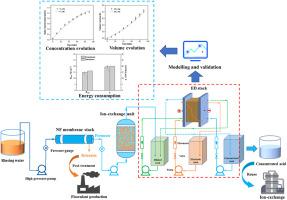基于电渗析的酸回收的整体传质方法
IF 9
1区 工程技术
Q1 ENGINEERING, CHEMICAL
引用次数: 0
摘要
低浓度废酸(如 pH 值为 0.5)的回收利用因其普遍性、可观的产量和巨大的潜在价值而备受关注。值得注意的是,在实际应用中,分离出的酸通常需要进一步浓缩,而电渗析(ED)已被公认为是一种有效的方法。然而,与盐系统相比,包括质子泄漏在内的各种因素使电渗析在酸系统中的应用变得更加复杂。本研究首次利用整体传质(OMT)方法为基于电渗析的酸回收提供了一种新型建模方法。重要的是,在对酸介质和电场对质量传输现象的影响进行定量分析后,基于一系列精心设计的实验,开发了将初始浓度和电流密度作为自变量的回归模型,用于计算 OMT 系数和电池电阻。随后对典型的基于电解质的酸回收过程进行了预测,结果与实验数据非常吻合。例如,浓度和体积演化的相对偏差分别小于 ±8.4 % 和 ±7.9%。此外,整个过程和 ED 堆的能耗相对偏差分别为 8.2 % 和 3.2 %。此外,还利用推导出的模型进行了模拟,以评估运行条件对 ED 性能的影响。总之,OMT 方法对酸系统中 ED 过程建模的有效性已得到证实。可以合理地断言,所开发的模型将有助于基于 ED 的酸回收工艺的生产管理和操作条件优化。本文章由计算机程序翻译,如有差异,请以英文原文为准。

Overall mass transfer approach for electrodialysis-based acid recovery
The reclamation of low-concentration waste acid (e.g., pH > 0.5) has garnered significant attention due to its prevalence, substantial output, and considerable potential value. Notably, a further concentration of the separated acid is typically required for practical applications, for which electrodialysis (ED) has been widely acknowledged as an effective method. However, various factors, including proton leakage, complicate the application of ED in acid systems compared to salt systems. This study presents a novel modeling approach for ED-based acid recovery utilizing the overall mass transfer (OMT) methodology for the first time. Importantly, regression models incorporating initial concentration and current density as independent variables have been developed to calculate the OMT coefficients and cell resistance following a quantitative analysis of the effects of acid media and electric field on mass transport phenomena, based on a series of carefully designed experiments. Subsequent predictions regarding a typical ED-based acid recovery process were conducted, yielding results that align closely with experimental data. For instance, the relative deviations for concentration and volume evolution were found to be less than ±8.4 % and ±7.9 %, respectively. Additionally, the relative deviations for energy consumption were recorded at 8.2 % and 3.2 % for the overall process and the ED stack, respectively. Furthermore, simulations were performed to evaluate the impacts of operational conditions on ED performance using the derived models. In conclusion, the efficacy of the OMT approach for modeling the ED process in acid systems has been substantiated. It is reasonable to assert that the developed models will be beneficial for production management and the optimization of operating conditions in ED-based acid recovery processes.
求助全文
通过发布文献求助,成功后即可免费获取论文全文。
去求助
来源期刊

Journal of Membrane Science
工程技术-高分子科学
CiteScore
17.10
自引率
17.90%
发文量
1031
审稿时长
2.5 months
期刊介绍:
The Journal of Membrane Science is a publication that focuses on membrane systems and is aimed at academic and industrial chemists, chemical engineers, materials scientists, and membranologists. It publishes original research and reviews on various aspects of membrane transport, membrane formation/structure, fouling, module/process design, and processes/applications. The journal primarily focuses on the structure, function, and performance of non-biological membranes but also includes papers that relate to biological membranes. The Journal of Membrane Science publishes Full Text Papers, State-of-the-Art Reviews, Letters to the Editor, and Perspectives.
 求助内容:
求助内容: 应助结果提醒方式:
应助结果提醒方式:


